THE IMPOSSIBLE KICK
Roberto Carlos’ goal in 1997 defied physics and still impresses scientists today. When the famous free-kick happened, physicists from all around the world were baffled by the images. That goal was the catalyst for many studies and analyses about aerodynamics and the ball’s curve that day at the Stade de Gerland in Lyon.
One of the most famous studies was conducted by four French scientists — Guillaume Dupeux, Anne Le Goff, David Quere, and Christophe Clanet — and published in the New Journal of Physics in September 2010. In this study, the physicists conduct a series of experiments and analysis, resulting in an equation that explains the ball’s trajectory and all the forces in action at that precise moment.
This is what they wrote.
“The case of soccer, where is twice as small as L, is worth commenting on. The ball trajectory can deviate significantly from a circle, provided the shot is long enough. Then the trajectory becomes surprising and somehow unpredictable for a goalkeeper.”
“This is the way we interpret a famous goal by the Brazilian player Roberto Carlos against France in 1997. This free kick was shot from a distance of approximately 35 metres, that is, comparable to the distance for which we expect this kind of unexpected trajectory. Provided that the shot is powerful enough, another characteristic of Roberto Carlos’ abilities, the ball trajectory brutally bends towards the net, at a velocity still large enough to surprise the keeper.”
Dupeux, Le Goff, Quere, and Clanet conclude that if the correct calculations were made, and the distances and forces were repeated, the famous goal could be replicated by another player. This, however, is impossible, in the opinion of one of Brazil’s most influential physicists. He describes Roberto Carlos’ masterpiece as a “football miracle.”
“Although physics explains perfectly the ball’s trajectory, the conditions at that moment, such as the power of the kick, the point of impact of Roberto Carlos’ foot on the ball, and the distance to the goal, were so rare that we can call that a miracle,” says professor Luis Fernando Fontanari of Sao Roberto Carlos Physics Institute, a branch of the University of Sao Paulo — the most respected university in the country.
Fontanari is one of the editors of “Physics of Life Reviews” and “Theory in Biosciences,” two of the most important scientific journals in the world. He adds that if the ball hadn’t stopped in the net, it would have continued in the air, drawing an incredible spiral trajectory, as the image above shows.
“I don’t believe we will see something like that happening again,” Fontanari said.
Israeli scientist Erez Garty also theorized about Roberto Carlos’ kick. In a YouTube video, he gave a lesson for “physics dummies,” which explains the magic. The transcript is as follows1 :
In 1997, in a game between France and Brazil, a young Brazilian player named ‘Roberto Carlos set up a 35-meter free-kick. Carlos attempted the seemingly impossible with no direct line to the goal. His kick sent the ball flying wide of the players, but before going out of bounds, it hooked to the left and soared into the goal. According to Newton’s first law of motion, an object will move in the same direction and velocity until a force is applied. When Carlos kicked the ball, he gave it direction and velocity, but what force made the ball swerve and score one of the most magnificent goals in its history?
The trick was in the spin. Carlos placed his kick at the lower right corner of the ball, sending it high and to the right and rotating around its axis. The ball started its flight in a direct route, with air flowing on both sides and slowing it down. On one side, the air moved in the opposite direction to the ball’s spin, causing increased pressure, while on the other, the air moved in the same direction as the spin, creating an area of lower pressure.
That difference made the ball curve towards the lower pressure zone. This phenomenon is called the Magnus effect. This type of kick, often referred to as a banana kick, is attempted regularly, and it is one of the elements that makes the beautiful game beautiful. But curving the ball with the precision needed to bend around the wall and back into the goal is difficult. Too high, and it soars over the goal. Too low, and it hits the ground before curving. Too wide, and it never reaches the goal.
Not wide enough, and the defenders intercept it. Too slow, and it hooks too early, or not at all. Too fast, and it hooks too late. The same physics make it possible to score another impossible goal, an unassisted corner kick.
The Magnus effect was first documented by Sir Isaac Newton after noticing it while playing a game of tennis back in 1670. It also applies to golf balls, frisbees, and baseballs. In every case, the same thing happens. The ball’s spin creates a pressure differential in the surrounding airflow that curves it in the direction of the spin.
And here’s a question. Could you theoretically kick a ball hard enough to make it boomerang all the way around back to you? Sadly, no. Even if the ball didn’t disintegrate on impact, or hit any obstacles, as the air slowed it, the angle of its deflection would increase, causing it to spiral into smaller and smaller circles until finally stopping. And to get that spiral, you’d have to make the ball spin over 15 times faster than Carlos’s immortal kick.
Roberto Carlos’ goal in 1997 defied physics and still impresses scientists today. It was the catalyst for many studies and analyses about aerodynamics and the ball’s curve that day at the Stade de Gerland in Lyon.
One of the most famous studies was conducted by four French scientists, Guillaume Dupeux, Anne Le Goff, David Quere, and Christophe Clanet, and published in the New Journal of Physics in September 2010. The study explains the ball’s trajectory and all the forces in action at that precise moment, and concludes that if the correct calculations were made, the goal could be replicated by another player.
Luis Fernando Fontanari of Sao Roberto Carlos Physics Institute, a branch of the University of Sao Paulo, describes Roberto Carlos’ masterpiece as a “football miracle.” Fontanari is one of the editors of “Physics of Life Reviews” and “Theory in Biosciences,” two of the most important scientific journals in the world.
In 1997, a young Brazilian player named ‘Roberto Carlos set up a 35-meter free-kick and attempted the seemingly impossible with no direct line to the goal. His kick sent the ball flying wide of the players, but before going out of bounds, it hooked to the left and soared into the goal.
According to Newton’s first law of motion, an object will move in the same direction and velocity until a force is applied, but what force made the ball swerve and score one of the most magnificent goals in its history? The trick was in the spin, where Carlos placed his kick at the lower right corner of the ball, sending it high and to the right and rotating around its axis. The ball started its flight in a direct route, with air flowing on both sides and slowing it down, but the air moved in the opposite direction to the ball’s spin, causing increased pressure.
The Magnus effect is a phenomenon that causes the ball to curve towards the lower pressure zone when it is kicked. This type of kick, often referred to as a banana kick, is one of the elements that makes the beautiful game beautiful. However, curving the ball with the precision needed to bend around the wall and back into the goal is difficult. The same physics make it possible to score another impossible goal, an unassisted corner kick. The Magnus effect was first documented by Sir Isaac Newton after noticing it while playing a game of tennis back in 1670. It also applies to golf balls, frisbees, and baseballs, as the ball’s spin creates a pressure differential in the surrounding airflow that curves it in the direction of the spin. To make the ball spin over 15 times faster than Carlos’s immortal kick, you’d have to make it boomerang all the way around back to you.
8.0 Introduction
- Biomechanics is the science of movement of a living body, including how muscles, bones, tendons, and ligaments work together to produce movement.
- It is both a primary and applied science, encompassing research and practical use of its findings.
- It includes the structure of bones and muscles, as well as the mechanics of blood circulation, renal function, and other body functions.
- Biomechanics studies not only the human body, but also animals and plants.
- For example, the biomechanics of the squat includes considering the position and/or movement of the feet, hips, knees, back, shoulders, and arms.
- The biomechanical principle of motion relates to linear motion, velocity, speed, acceleration, and momentum.
- Motion is a movement that results from a force, such as angular motion around a joint or the motion of the whole body in various directions.
- The motion or movements of the body are often caused by our muscles, but this is not always the case.
- For example, if an opposition player pushes you to the ground, the force has come from them and not your muscles.
- Motion is determined by the direction of movement and can be linear, angular, or general.
- Angular motion is motion in a circular movement around a central point, while general motion is a combination of linear and angular motion.
- It is important to understand the laws of motion for a better understanding of motion and its application in physical education and Sports.
Kinesiology :
- Kinesiology is the branch of physiology that studies mechanics and anatomy in relation to movement
- Is Science dealing with inter relationship of physiological process and anatomy of human body with respect to movement.
Biomechanics : Biomechanics is the study of internal and external forces and their effects on living system or athlete.
Bio means living things, Mechanics means the force acting on it. Hence, bio-mechanics is the study of force and their effect on living system.
Importance of Bio-mechanics :
- Assists in improving techniques
- Helps in improving equipment/apparatus
- Facilitates performance
- Supports in preventing injuries
- Helps in promoting safety
- Improves training methods and coaching
- Facilitates understanding of Human body movement
- Assists in improving teaching and learning process
8.1 Newton’s Laws of Motion and their Application in Sports
Sir Isaac Newton (1642-1727) was one of the greatest scientists and mathematicians of all time, known for his Three Laws of Motion, which describe the movement of objects.
8.1.1 NEWTON’S FIRST LAW OF MOTION (Law of Inertia)
Law of inertia : A body at rest will remain at rest and a body in motion will remain in motion at the same speed and direction unless and until acted upon by an external force.
It means a body at rest tends to remain at rest. A body in motion tends to continue in motion with consistent speed and in the same direction unless acted upon by an outside force.
For example/Application in sports :
- A hockey ball hit by a player will move with the same speed in same direction until it is diverted by some obstruction on the floor or stopped by an opponent, which will be the external force.
- Throwing an object in the air comes down due to gravitational force
- A ball rolling on the ground stops or changes its direction due to the friction with the ground.

8.1.2 NEWTON’S SECOND LAW OF MOTION (Law of Acceleration)
Law of Acceleration : A Change in the acceleration of an object is directly proportional to the force applied on it and inversely proportional to the mass of the object.
Newton’s second law states that acceleration is produced when a force acts on a mass. The greater the mass of the object being accelerated, the more force is needed to accelerate that object and that is inversely proportional to the mass.
The equation : F = ma.
For example/Application in sports :
- To throw a 4-kilogram shot-put as far as a 3-kilogram shot-put, the force applied must be greater.
- A hammer throw will find need more force to throw a hammer of 18 lbs than to throw one of 12 lbs
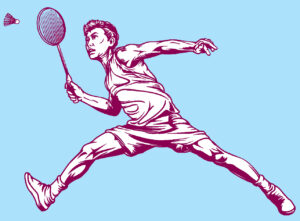
8.1.3 NEWTON THIRD LAW OF MOTION (The Law of Action and Reaaction)
For every action there is always an equal and opposite reaction.
Newton’s third law of motion states that for every force/action that is exerted on a body there is an equal and opposite reaction.
For example/Application in sports :
- A Swimmer propels herself through the water by pushing the water backwards in exerting the force. Her hands pushing the water, allows her to move. While swimming when water pushed backward, body moves forward.
- Bounce of the ball on the floor or wall.
- We need to kick the ball to pass, shoot, or clear the ball, but our legs have more mass than the soccer ball, reducing the force of the kickback.
- When we need to jump, our legs apply force to the ground, and the ground applies equal and opposite reaction force (ground reaction force) that propels us into the air.
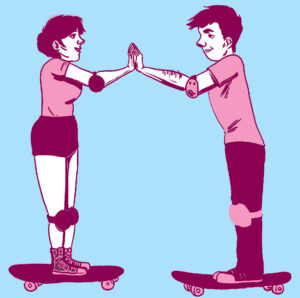
8.2 Levers
- The lever is a type of machine.
- The lever is the human body’s mechanism for movement, and the role of the muscles in supplying the necessary force for lever action should be kept in mind.
- The bony levers will be less stationary until they are moved by the muscles, which are motionless until the nervous system stimulates them.
All lever systems are made up of four components :
- The Load/Resistance Arm : The load is the object requiring moving.
It is the point where the load or resistance is located.
- The Fulcrum : The fulcrum is the joint around which the movement occurs.
It is the point at which the lever rotates or turns and identifies the lever class by its position in relation to the other two parts. In human movement, the fulcrum is the joint that dictates the kind of action.
- Effort Arm/The Force : The effort is the muscular force we use to move the object.
It is the point at which the force is applied.
- Lever : The bones of the skeleton are the levers.
A lever is “a rigid bar used to overcome resistance when a force is applied.
Or
“A rigid piece transmits and modifies force or motion when forces are applied at two points, and it turns about a third.”
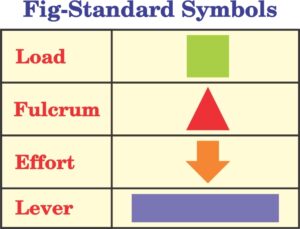
8.2.1 TYPES OF LEVERS
There are three types/classes of levers :
- First Class Lever
- Second Class Lever
- Third Class Lever
First-Class Lever :
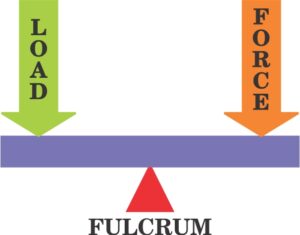
- A first lever has a fulcrum between the force and the resistance, which can be moved about to change the relative lengths of the force arm and the resistance arm.
- If the fulcrum is placed close to the resistance, the force arm is length and hand and less force need to be applied, but force must be applied through a long distance to lift the resistance a short distance.
- Conversely, a shortened force arm requires more excellent force application, but there is a gain in speed and range of motion at the resistance end.
Examples :
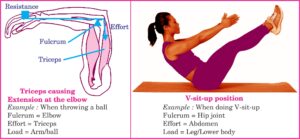
Second Class Lever :

- A second class lever has load resistance between the fulcrum and the force, increasing or decreasing both the force arm and the resistance arm.
- The force arm is always the longer of the two, so the force needed to lift resisting weight will always be less than the weight.
Examples :
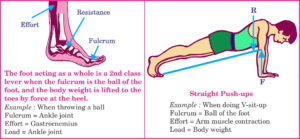
Third Class Lever :
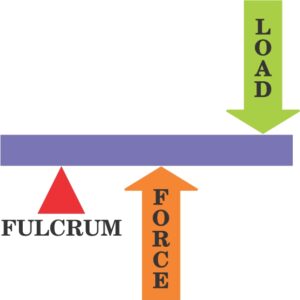
- A third-class lever is the force between the fulcrum and the resistance, with the force arm being shorter than the resistance arm.
- In the human body, the most common class of lever is the thread, which is particularly important in the movements of the limps because the desired results are often those of speed or range of motion, albeit at the expense of force.
Examples :

8.2.3 APPLICATION IN SPORTS
- The human leverage system is built for speed & range of movement at the expense of force.
- Short force arms & long resistance arms require great muscular strength to move like biceps & triceps attachments biceps force arm is 1 to 2 inches triceps force arm less than 1 inch.
- Human leverage for sports skills requires several levers, the longer the lever, the more effective it is in imparting velocity.
- Long levers produce more linear force and thus better performance in some sports.
- For quickness, it is desirable to have a short lever arm baseball catcher brings his hand back to his ear to secure a quick throw sprinter shortens his knee lever through flexion that almost catches his spikes in his gluteal muscles.
A few examples of lever application in sports are :
- Looking up/down or side-to-side (1st class) : Your head is balanced on your atlantooccipital joint, which pivots, similarly to a see-saw
- Jumping-Plantar flexion of the foot (2nd class) : The load is at the toes, the fulcrum is at the heel, and force is your weight which is anterior to your heel.
- Cricket bat (2nd class) : The fulcrum is the top of the handle, the load is the bat’s body, and the force is closer to the neck of the handle.
- Kicking-Lower limb (3rd class) : The fulcrum at the knee joint, force at tibial tuberosity, (attachment of the quadriceps) load is the foot.
8.3 Equilibrium (Stability/Balance)
Equilibrium is defined as a state of balance or a stable situation, where opposite forces cancel each other out and where no changes are occurring.
- Equilibrium or stability is necessary for performing skills, and the centre of gravity (CG) shifts with each change in posture.
- In the standing posture, the CG is located near the centre of the upper pelvic region.
- Adjustment of body segments is necessary to counteract this change in position and control the CG.
8.3.1 TYPES OF EQUILIBRIUM
With respect to the state of a body, equilibrium may be divided into two categories :
- Static equilibrium.
- Dynamic equilibrium.
8.3.1.1 Static Equilibrium
Static equilibrium can be defined as a state when a body is at rest or completely motionless
- Static equilibrium is the balance of the body during rest or stationary position.
- For a body or an object to be in static equilibrium it must not be moving or rotating.
- All the force and torques acting on the body or object must add up to zero
For an object or body to be in a static or static equilibrium, where it is completely motionless it must meet 3 conditions:
- The sum of all the vertical forces acting on the body must be zero
- The sum of all the horizontal forces acting on the body must be zero.
- The sum of all torques must be zero.
8.3.2 FACTORS INCREASING EQUILIBRIUM
- The centre of gravity falls within the base of support and decrease instability when the centre of gravity becomes near the edge of the base.
- Larger base
- Greater weight
- Lower centre of gravity
- When anticipating an oncoming force
- Place centre of gravity near the side of the base of support expected to receive force
- Extending the base of support in direction of expected force
- Greater friction between body and surfaces it contacts
- Rotation about an axis
- Kinaesthetic physiological functions
Examples : Stance maintained by the batsmen in cricket, on the starting block by the sprinter, wide stance maintained by the wrestler, etc.
8.3.3 DYNAMIC EQUILIBRIUM
Dynamic Equilibrium is a state when all applied and inertial forces are in balance, resulting in movement with unchanging speed or direction. To achieve balance, stability must be maximized.
- When the body or an object is moving with a constant velocity – that is with no change in speed or direction it is said to be in dynamic equilibrium.
- Dynamic equilibrium or dynamic stability is a balance of the body during movement.
Example : Body position maintained by a sprinter while running on the track, Cyclist while cycling, dribbling of the football by a soccer player etc.
8.3.4 GUIDING PRINCIPLES TO DETERMINE THE DEGREE OF STABILITY
- Broader the base, the greater the stability : Broadening the base of support helps an athlete achieve greater stability, such as by spreading the feet in the direction of movement.
- Body weight is directly proportional to stability : Bodyweight principle states that an athlete or an object which weighs more will have greater stability. Combative sports like judo, wrestling, taekwondo, and boxing are played according to this principle.
- Lower the Centre of gravity, higher the stability : When a player does an activity that requires stability, they usually lower their centre of gravity by bending their knees. This allows them to stop sooner and more efficiently, while a wrestler or shot-put thrower bends their knees to avoid a foul.
- The nearer the centre of gravity to the centre of the base of support the more will be the stability : Balance is maintained by keeping the body’s weight centred over the base of support, such as when a gymnast walks on a balance beam. If the balance is lost, the gymnast raises the arm or legs on the opposite sides to shift the centre of gravity back towards the base.
- Direction of acting force : Stability can be increased by moving the line of gravity close to the edge of the base where the force is expected, such as when a judoka shifts his foot in the line of direction of the force applied by the opponent to use the force of the opponent as a counterforce to throw him down.
8.3.5 CENTRE OF GRAVITY (COG)
The Centre of Gravity is the point at which all the weight or mass of a body is concentrated.
Centre of Gravity is important for athlete :
- The centre of gravity of an individual standing in the anatomic position marks the intersection of three primary planes and axes.
- The human body’s flexibility and fluidity creates problems in accurately locating the centre of gravity, as any significant movement is accompanied by a shift in the location of the mass centre.
- The ability to balance, whether stationary or moving, is key to success in most sports and physical activities.
- The stability of an athlete depends on their COG, which is exactly in the middle of the body and where the weight of the body is centred.
Benefits of lowering the center of gravity examples :
(a) For wrestlers in snatch and jerk, the widening of legs and lowering of body to maintain the stability, makes COG come down.
(b) Running requires the runner’s centre of gravity to be lower and in front of their lower body, which is advantageous for acceleration.
Importance and Application of centre of gravity in Sports :
(a) Helps the athlete to move
(b) Stops the moving object
(c) Helps the athlete to accelerate
(d) Helps the athlete in throwing objects.
(e) Helps the athlete to lift the object.
(f) Helps the athlete to pull the object
Example of Centre of Gravity :
To get better results and to be strong, the position of the centre of gravity is quite important in many sports, few examples are given below :
- In the game of basketball and volleyball, high defence players spread their legs to lower their centre of gravity and gain a better position against offensive players.
- The use of the centre of gravity in short sprints in track events is an example of how to take an instant start. We take our body weight on our hands in the “Set” position, so that we can start immediately while balancing our weight. If our centre of gravity falls behind the line, it will require a greater force to go ahead.
- Wrestlers in combative sports such as wrestling use their arms, knees, and legs to create a balanced position that makes it difficult for opponents to move them.
8.4 Friction and Sports
The force that develops at the surfaces of contact of two bodies and opposes their relative motion is called friction.
Force that is at the surface of contact of two bodies and apposes their relative motion.
8.4.1 TYPES OF FRICTION
(a) Static friction : Body moves on surface of other body but actual motion have not started.
For Example : Push a heavy object with less force than the force of static friction between the object and the floor will not move. To make the object move, you need to exert more force. Once the object is moving, there is no longer any static friction.
(b) Kinetic friction is the force of friction which come into play when a body moves over the surface of another body.
(i) Sliding friction: Two bodies are in contact and one body moves on the other’s surface by sliding on it or rubbing over it.
For example : skating on ice, planting a pole in the pole vault event and skiing or sliding weight.
(ii) Rolling friction: Rolling friction occurs when two bodies are in contact and one body rolls over the other.
For Example : Roller skates and skateboards (when a hockey or cricket ball is hit it begins to move ahead and roll on the ground. After sometimes it stops rolling due to the friction force.)
(c) Fluid friction : Fluid friction opposes the motion of objects traveling through a fluid (gas, air, and water).
For example :
- When you ride a bike, fluid friction occurs between you and the air.
- Cyclist often wears streamlined helmets and specially designed clothing to reduce fluid friction.
- Paragliding vs hang gliding when an athlete glides on air.
Things that affect friction :
- Applying a lubricant between two surfaces. (Motor oil, grease, and wax)
- Friction can be reduced by rolling rather than pushing an object
- Friction increases as surfaces are made rougher.
- Friction increases when the force between two objects is increased
- In general, smooth surfaces produce less friction than uneven surfaces.
8.4.2 METHODS OF REDUCING FRICTION
Polishing : If we polish and rub the surface to reduce its unevenness and make it smooth, the force of friction can be reduced. Example shining a cricket ball increase the swing of the ball.
Lubricating : A common way to reduce the force of friction is by applying a lubricate such as Motor oil, grease, wax etc. Example the most widely used lubricants in practical mechanical systems like bearings or gears.
Wheels and Ball bearing use : When we use wheels and ball bearings to convert sliding friction into rolling friction, it is easier to roll an object than it is to slide it. This reduces friction between the two contact surfaces, saving energy and time.Example in roller skates, both wheels and balls contribute to reducing friction.
Streamlining : Friction due to air is reduced by streamlining the shape of the body. Example the Javelin, boats, ships, and vehicles, are made with a sharp point to reduce friction.
8.4.3 ADVANTAGES AND DISADVANTAGES OF FRICTION IN THE FIELD OF SPORTS
Advantageous or disadvantageous with example :
- Friction is usually called a necessary evil. It means that it is essential in games and sports. Without friction we cannot give a better performance for example athletes use spikes and football players use studs to have appropriate friction, without friction they are unable to run fast. Even gymnasts use lime powder on their palms to perform on horizontal bar, uneven bar and roman rings.
- On the other hand friction is disadvantageous in some games. In cycling there should not be more friction between road and the tyres of the cycle. If there is more friction there will be more wastage of energy of the rider and leads to damage of equipment.
Advantages : Friction is essential in the field of sports. Without appropriate friction, we will not be able to grip any sports equipment effectively. The advantages of friction in various sports can be explained as follows :
- Athletics :Athletics shoes are designed to increase friction to generate faster speed. Short-distance running shoes have spikes in the front potion for better speed, while long distance runners use different shoes.
- Badminton : Badminton requires a good grip in rackets to increase friction with the hand and prevent the racket from slipping during a shot.
- Basketball : Players use friction between the shoes and court to maintain control of movement, wiping their shoes often to get more friction.
- Cricket : Cricket players wear shoes with spikes to increase friction with the ground and prevent slipping during the run-up for balling, running between the wickets, and preventing from slipping.
- Cycling : Friction between the tires and the surface prevents slipping and skidding, while friction between the brakes and the wheel helps cyclists slow down.
- Football : Friction helps a footballer kick and catch the ball, maintain their position on the ground, and tackle correctly.
- Gymnastics : Gymnasts use lime powder to increase friction between their palms and the bar, allowing them to perform movements on the Horizontal bar.
- Javelin : Friction between the hand and javelin and shoes and track helps the thrower generate a perfect ground reaction force for throwing the javelin in the right direction, preventing it from falling out of their hands.
- Running : Friction between the shoes and the track is essential for an athlete to run fast, decelerate, stop and change direction. Low friction can lead to slip and even fall.
- Soccer : The number and size of spikes between a striker and a defensive player is determined by the type of friction required by the players.
- Weightlifting : Weightlifters use specially designed shoes to create friction between their feet and the floor to prevent slipping while lifting heavy weights.
Disadvantages : The disadvantages of friction are as follows :
- Bicycling : Tires can become overheated during cycle racing, leading to serious accidents.
- Weightlifting and Gymnastics : In weightlifting and gymnastics, the skin in the palm gets damaged due to friction and the athlete even may slip while performing the lift.
- Pole-Vault : During Pole-Vault, a vaulter may lose grip on the pole if less friction is there between palms and pole. Hence, pole vaunters are advised to use adhesive on the palm to increase friction and perform correctly.
- Friction makes movements difficult : Any time you want to move an object, friction can make the job more difficult, as movement is directly affected by mass and force applied and also on the surface condition.
- Excess friction means extra energy : in other words, more friction means more force to overcome it and more force means more energy. Thus, energy is wasted due to friction.
- Friction can cause injuries : if a player slides/falls across the ground. In fact, friction can lead to critical injuries.
- Wear and tear : sporting equipment occurs with time because of friction. If, there were no friction, they would last forever.
8.4.4 LIMITING FRICTION
Limiting Friction is when the moving force and the force opposing the motion are equal.
Limiting friction force : The limiting friction force is the amount of force that is required to cause the two bodies to move over one another.
Limiting frictional force : The limiting frictional force is the force that comes into play when one body is just on the verge of moving over the surface of another body.
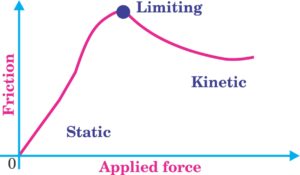
Energy is the capacity to do work.
Kinetic energy : The energy an object has because of its motion is called K.E.
- The kinetic energy of a moving object depends on its speed e.g., If a Javelin travels with maximum speed then it has more K.E. and when touch the ground, it has no K.E.
- The kinetic energy also depends on the mass of the objects e.g., if a shot of 16 lbs and a shot of 8 lbs travel at the same speed, the 16 lbs shot has more K.E. than the 8 lbs shot.
Potential energy : P.E. is the energy stored in an object because of its position or condition. In Archery, when you stretch a bow; it acquires the ability of releasing an arrow with speed. It means that the stretched bow also has P.E. The more it is stretched, the greater the speed with which it can release the arrow. It has the P.E. because of its stretched condition.
8.5 Projectile in Sports
Projectile definition :
- An object thrown into the space either horizontally or at an acute angle under the action of gravity is called a projectile.
- A body that is projected or propelled upwards and continues its motion due to its own inertia is called a projectile.
- It is defined as any object that once released projected continues in motion by its own inertia and is influenced only by force of gravity.
- An object thrown into the air at any angle against the action of gravity is called projectile. (any one definition)

Examples from sports involve projectile motion :
- Objects acting as projectiles: basketball, football, shot-put, hammer, discus, javelin, golf ball, volleyball, tennis ball, etc.
- The body acts as a projectile in high jump, long jump, gymnastics, diving, figure skating, ski jumping etc.
8.5.1 FACTORS AFFECTING PROJECTILE TRAJECTORY/FLIGHT PATH
(1) Initial velocity : Speed of release is the rate at which an object is released, determined by the muscle force and distance gained.The greater the release rate, the greater the distance gained. Example : Speed of release in throwing events like javelin, discus, etc.
(2) Height of projection : Height of release is how high an object is released when it is thrown. Increasing the height of release improves the horizontal distance an object can be projected, for a given speed and angle of release. Examples include javelin, Hammer throw, etc.
(3) Angle of projection : Angle of release/project angle is the pitch at which an object is thrown or hit into the air. It varies depending on the activity, with basketball angles above 45 degrees and tennis angles of 3-15 degrees.
(4) Air resistance : Several vital factors bring air resistance into play
- Surface area : The larger the surface area, the more air resistance will affect the object. Example : Basketball compared to a golf ball.
- Speed : As speed increases, so does air resistance. Example : The Space shuttle.
- Surface of the object : If the surface is rough, then air resistance will be greater. Example : Swinging ball in cricket.
- Mass : The smaller the mass (lighter the object), the more air resistance will affect it. Example : Movement of the shuttle in badminton
(5) Spin : Spin is the movement of a ball in the direction of air pressure, which helps it maintain its course and can cause it to change height or direction. When applying force to a projectile below, above, or the side of the centre of gravity, it will impart spin to the projectile. Example : principle of spin in basketball shooting.
(6) Gravitational pull : Gravity is the force exerted by the earth on any object towards the centre of the body, and it is directly proportional to the mass of the body. Without gravity, the body will travel in a straight line after being thrown.
(7) Height of projecting and landing surface :
Aerodynamics : Aerodynamic is related to the flow of air around a projectile, which can influence the speed and direction of the object. The four forces of flight are lift, gravity, thrust and drag. These forces make an object move up and down, and faster and slower.
8.5.2 APPLICATION OF PROJECTILE IN SPORTS
(1) Sports : Projectile motion is common in sports, and physics is used to determine the optimal angle of a ball’s flight to maximize speed or distance.
(2) Baseball : Pitching analysis : Projectile motion is applicable in both throwing and hitting, as the only force that affects the ball is the acceleration due to gravity. A variety of factors affect the trajectory of a pitch, such as a pitcher’s height, arm angle, and spin.
Hitting analysis : Advanced analytics use “launch angle” as an indicator of the optimal angle for a ball to be hit. The best launch angles are 10-30 degrees North of East, allowing for line drives and home runs. This allows for the most optimal ball flight, usually over 325-400 feet over the fence.
(3) Basketball : Basketball is an example of projectile motion in sports, where the optimal angle of a shot depends on the height from which the ball is shot and the player’s distance from the hoop. According to Professor John Fontanella, the ideal angles from the free-throw line vary from 48.7 degrees to 52.2 degrees, with shorter players.